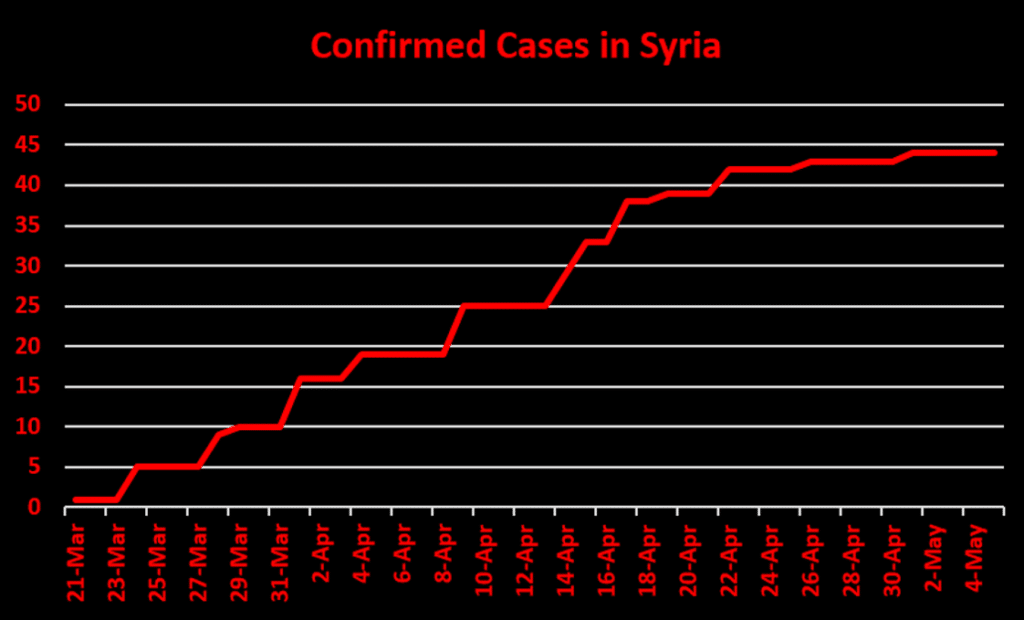May 5, 2020 | Policy Brief
COVID-19 in Northeast Syria
May 5, 2020 | Policy Brief
COVID-19 in Northeast Syria
The reported number of coronavirus cases in northeast Syria remains in single digits, in part because healthcare workers have so little ability to test for the virus. Local authorities are preparing for the possibility of a major outbreak, yet the regime of Bashar al-Assad continues to block the provision of UN assistance, while the World Health Organization (WHO) defers to the regime’s wishes.
Situation Overview
Central authorities in Damascus have reported 44 cases all together but only a single positive test from northeast Syria, which has an estimated population of 3 million. The Autonomous Administration of North and East Syria (AANES) reported two additional cases on April 30. The dominant force within the AANES is the PYD, a Syrian Kurdish party aligned both with the U.S.-led coalition against the Islamic State and with the Turkish Kurdish PKK, a U.S.-designated terrorist organization.
As of April 6, the WHO had provided the regime with five polymerase chain reaction (PCR) machines for testing samples, but Syria’s Ministry of Health sent none of them to the northeast.
Instead, local authorities had to send their samples to the central laboratory in Damascus, until they received two PCR machines from the government of neighboring Iraqi Kurdistan. According to the WHO, of the 1,500 tests conducted by the Damascus laboratory as of April 22, only 48 were from the northeast.
Until mid-April, the WHO itself also provided far greater assistance to Damascus than to the northeast. The WHO’s weekly report for April 25 indicates it has provided more than 1 million items of personal protective equipment (PPE) to the government since mid-February, including masks, gloves, aprons, gowns, headcovers, alcohol hand-rubs, and goggles. Meanwhile, the WHO delivered its first significant shipment of PPE and related equipment to the northeast via airlift on April 12. The report indicates the shipment weighed 20 metric tons, but the report does not list and quantify the contents the way it does for deliveries to the regime, so no direct comparison is possible.
COVID-19 in the Greater Middle East
| Country | Cases | Deaths |
| Turkey | 127,659 | 3,461 |
| Iran | 99,970 | 6,340 |
| Saudi Arabia | 30,251 | 200 |
| Pakistan | 21,501 | 486 |
| Qatar | 17,142 | 12 |
| Israel | 16,268 | 237 |
| UAE | 15,192 | 146 |
| Egypt | 7,201 | 452 |
| Kuwait | 5,804 | 40 |
| Morocco | 5,153 | 180 |
| Algeria | 4,838 | 470 |
| Bahrain | 3,679 | 8 |
| Afghanistan | 3,224 | 95 |
| Oman | 2,735 | 12 |
| Iraq | 2,346 | 98 |
| Tunisia | 1,018 | 43 |
| Somalia | 835 | 38 |
| Sudan | 778 | 45 |
| Lebanon | 741 | 24 |
| Jordan | 465 | 9 |
| W. Bank & Gaza | 366 | 2 |
| Libya | 63 | 3 |
| Syria | 44 | 3 |
| Yemen | 21 | 3 |

Data current as of 11:30 AM, May 5, 2020.
Implications
Globally, the COVID-19 pandemic has spread rapidly throughout some countries while appearing to pass by their neighbors. So far, there is no clear explanation for this inconsistency. With its poverty, battered healthcare system, and mass of displaced person, Syria appears exceptionally vulnerable. As a UN report confirmed last month, the Assad regime has deliberately bombed healthcare facilities. Yet so far, the pandemic has mostly spared Syria, including the northeast.
The region’s healthcare system remains vulnerable to Assad’s machinations, however. In January, Russia leveraged its Security Council veto to prohibit UN agencies from delivering aid to northeast Syria from Iraq. Since Assad has co-opted the UN’s Damascus-based operations to serve the regime’s political and military purposes, blocking the arrival of UN assistance from Iraq made the flow of UN aid effectively dependent on Assad’s approval.
In a report on the impact of restricting deliveries from Iraq, the UN secretary-general observed that “only 2 out of 16 public hospitals and 4 out of 279 primary health centres across the north-east were functioning at full capacity.” Throughout 2019, the Assad regime had blocked requests to deliver medical assistance to the northeast via land from Damascus. Accordingly, medical facilities across the region depended on UN medical supplies arriving through Iraq.
What to Watch for
The UN Security Council will revisit the issue of cross-border aid when its current resolution expires in July. A concerted effort by the United States, United Kingdom, and France to publicize the human cost and political calculus behind the prohibition could effectively pressure Russia to compromise.
The United States and its partners should also monitor the WHO, whose deference to Assad persists. Last week, Reuters reported that the final version of a WHO report to the Security Council deleted reference to an urgent appeal from aid groups to re-open the border to aid deliveries through Iraq. It appears that only a root and branch overhaul of UN aid agencies can restore their commitment to independence and impartiality.
David Adesnik is research director and a senior fellow at the Foundation for Defense of Democracies (FDD), where he also contributes to FDD’s Center on Military and Political Power (CMPP). For more analysis from David and CMPP, please subscribe HERE. Follow David on Twitter @adesnik. Follow FDD on Twitter @FDD and @FDD_CMPP. FDD is a Washington, DC-based, nonpartisan research institute focusing on national security and foreign policy.